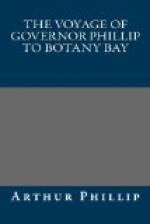The number of the natives in these inland parts must, however, be very small. Whether these reside by choice where they must encounter so many difficulties, or whether they are driven from the society of those who inhabit the coast, has not yet been discovered. The huts seen here consisted of single pieces of bark, about eleven feet in length, and from four to six in breadth, bent in the middle while fresh from the tree, and set up so as to form an acute angle, not a little resembling cards set up by children. In the plate inserted here, not only the huts, but some of the spears of the natives are introduced. It was conjectured, that the chief use of these imperfect structures might be, to conceal them from the animals for which they must frequently be obliged to lie in wait. They may also afford shelter from a shower of rain to one or two who sit or lie under them. The bark of many trees was observed to be cut into notches, as if for the purpose of climbing; and in several there were holes, apparently the retreat of some animal, but enlarged by the natives for the purpose of catching the inhabitant. The enlargement of these holes with their imperfect instruments, must itself be a work of time, and must require no little patience. In some places, where the hole was rather too high to be reached from the ground, boughs of trees were laid to facilitate the ascent. The animals that take refuge in those places are probably the squirrel, the opossum, or the kanguroo-rat. At the bottom of one of these trees, the skin of a flying squirrel was found.
In many places fires had lately been made; but in one only were seen any shells of oysters or muscles, and there not more than half a dozen. Fish-bones were not found at all, which seems to prove, that in their journies inland these people do not carry with them any provisions of that kind. Kanguroos were frequently seen, but were so shy that it was very difficult to shoot them. With respect to these animals, it is rather an extraordinary circumstance, that, notwithstanding their great shyness, and notwithstanding they are daily shot at, more of them are seen near the camp than in any other part of the country. The kanguroo, though it resembles the jerboa in the peculiarity of using only the hinder legs in progression, does not belong to that genus. The pouch of the female, in which the young are nursed, is thought to connect it rather with the opossum tribe. This extraordinary formation, hitherto esteemed peculiar to that one genus, seems, however, in New Holland not to be sufficiently characteristic: it has been found both in the rat and the squirrel kind. The largest kanguroo which has yet been shot weighed about one hundred and forty pounds. But it has been discovered that there are two kinds, one of which seldom exceeds sixty pounds in weight: these live chiefly on the high grounds: their hair is of a reddish cast, and the head is shorter than in the larger sort. Young kanguroos which have been taken,




